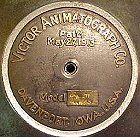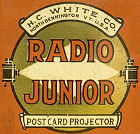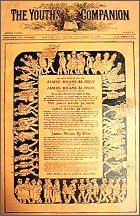 MANUFACTURERS, IMPORTERS, AND RETAILERS. U-Z |
||
|
References: To produce this extensive list the following sources were consulted: Encyclopaedia of the Magic Lantern. The Magic Lantern Society, London, England, 2001. Van Toverlantaarn tot Kinematograaf. Vera Tietjens-Schuurman. Stichting Peter Bonnet Museum, Rottevalle, Friesland, the Netherlands, 1979. Laterna Magica, Zauberwelt und Faszination des optischen Spielzeugs. Ernst Hrabalek. Keysers Sammlerbibliothek G.m.b.H., Regensburg, Germany, 1985. and others. |
||
UNDERHILL, ALFRED English slide maker who advertised as: 'Dissolving view artist, Photographer, Draughtsman and Lantern slide specialist; Designer and publisher of Mottoes, Curtains, Comics, Photographic, Slipping, Skipping, Levers, Chromatropes and Mechanical Slides'. Around 1900 an advertisement in the catalogue of the Croydon Camera Club offered a complete photographic service, and entertainment and lectures for schools, concerts and Christmas parties. (c. 1890-1915) |
||
UNDERHILL, HENRI MICHAEL JOHN English slide painter. Working as a grocer, in his spare time Henri was a deserving photographer who organised every year the entertainment for the children at the opening session of the 'Band of Hope', a temperance group for children, for which he painted his lantern slides. Usually he painted with watercolour and wrote about this technique in some magazines. Well-known sets are 'Drakestail' and 'Guleesh'. (c. 1890s) |
||
UNGER Partner of Wilhelm Hoffmann, from 1878 trading as Unger und Hoffmann A.G. Dresden, the company that produced almost hundred sets of photographic lantern slides under the name 'Projektion für Alle'. (c. 1878-1928) |
||
UNGER & HOFFMANN The Hoffman - Dresden company was founded around 1840 by Wilhelm Hoffmann as a paper mill. In 1878 it became, together with the manufacturer Unger, Unger & Hoffmann A.G. They produced, among other things, almost a hundred sets of lantern slides under the name 'Projektion für Alle'. (ca 1878-1928). In 1930 the company was taken over by Verax, after which the lantern slide industry was shut down. |
||
VALENTINE & SONS, J. Scottish slide manufacturers and photographers, working in Dundee. Valentines began as an offshoot of a photographic business specialising in landscape views and remained one of the relative minor slide producers. The advertised their slides as 'the Best Toned and most carefully-selected slides on the market.' After 1900 the firm became one of the larger producers of postcards. (1878-c.1900) |
||
VAN ALTENA, EDWARD American photographer and lantern slide maker, working in New York since 1894. In 1904 John Duer Scott became his partner to form Scott & Van Altena, producing hand coloured photographic slides, Life model slides and Singalong slides until 1919. When the firm was dissolved, Van Altena continued the production of slides alone again. |
||
 |
VICTOR ANIMATOGRAPH COMPANY The American magician and inventor Alexander F. Victor was born in Sweden, 1878. He joined a washing machine manufacturer that financed the Victor Animatograph Company. Victor designed among other things some lightweight stereopticons using cast aluminium for lightness. By November 1921 Victor had become the largest slide manufacturer in the US. The company was one of many that helped the stereopticon (magic lantern) develop into the 20th-century slide projector, with small format slides, automatic slide changing, and electric bulb illuminant. The company was a large producer of lantern slides using their "Featherweight" method: a single pane of glass with a shellac on the opposite side that protects the image, and prevents scratching. Featherweight slides are framed by a cardboard mat giving them the dimensions of 3 ¼ x 4 inch. They are notably thinner than most lantern slides of the era, and as a result more fragile and uncommon than those of competing makers. The Featherweight slides were less expensive but produced a high quality image. |
|
VÖTTER, BERNHARD German manufacturer of dissolving view lanterns in Gotha. (1870s) |
||
WALE & C0., GEORGE American lantern manufacturer in New Jersey, who made a range of scientific instruments and magic lanterns. Wale made the American-style vertical College Lantern, developed initially by J.P. Cook and Henri Morton, Professor of Chemistry and Physics at the University of Pennsylvania in the 1860s and an avid promoter of the lantern in education. (c.1865-) |
||
WATKINS, JEREMIAH British optical and scientific instrument makers in London, known to have sold magic lanterns from 1798. From 1819 until 1856 the business was known as Watkins & Hill and later it became a part of Elliott Brothers, a company which was closely associated with Negretti & Zambra. |
||
WATSON, W. English opticians and scientific instrument makers in London. Founder of Watson & Sons. |
||
|
|
WATSON & SONS Founded in 1837 the company added photographic equipment to it's assortment in the 1870s and became one of the country's leading manufacturers. The firm listed lanterns, slides and associated equipment from the 1840s. In their London factory they did their own woodwork, brass working and lens grinding. After taking over John Browning & Co. in 1900 the firm became W. Watson & Sons Ltd from 1908 and was active until after the Second World War. (1837-c. 1948) |
|
WAGNER, M. See: Plössl, Simon |
||
 |
WEDEA Publisher Wedea from Amsterdam released various sets of lantern slides under the name 'City-Series' in the 1930s. Most sets were published in both black and white and coloured versions. Some of the drawn stories in this series were: Roodkapje, Schoone Slaapster, Gulliver bij de Reuzen, Gulliver bij de Dwergen, Robinson Crusoë en Een-oogje, twee-oogje, drie-oogje. They also published sets of black and white photos on among others Artis (zoo), Marken and Volendam. |
|
WEEKS, FRANCIS FREDERICK THEOPHILUS English designer and producer of lantern slides, working in London from 1875 to at least the latter 1890s. Together with Joseph Riley Weeks applied for a patent in 1894, describing a method of photographing life models in front of a white background, the background details being painted in later, before a copy negative was made. Weeks specialized in living model and comic slides and photographed some 15 of the Riley series of 'Ben Hur' slides from 'living Jewish models' and drew several others. Many of the slides are an unusual combination of photography and painting. In 1898 Weeks was sentenced to seven years penal servitude for bigamy and abominable conduct to his daughters. The judge condemned him as 'a villain of the deepest dye'. |
||
WEGENER, HEINRICH German glazier who advertised painted lantern slides in Berlin. (1752) |
||
WEST & SONS English lantern slide makers and publishers. Their 1890s catalogue advertised a variety of maritime slides, including naval vessels, torpedo warfare, The North Sea Fisheries and 'Sailor Life Ashore and Afloat. |
||
WEST, FRANCIS English optical, mathematical and philosophical instrument maker in London. (1830s) |
||
WESTLEY, WILLIAM On of the participants in the business of Carpenter & Westley. |
||
WHEELER, DEWITT American lantern slide maker, active in New York. (c. 1900) |
||
 |
WHITE Co., H.C. Manufacturer of the Radioptican episcope and the Radio Junior postcard projector (c. 1920). North Bennington VT U.S.A. |
|
WHITFORD, SAMUEL British optical and scientific instrument maker in London, known to have sold magic lanterns. (1765-1789) |
||
WILKINSON & Co. A firm of English lantern slide colourists and painters in Sunderland that also offered effect and mechanical slides. (1859-189s) |
||
WILSON BROTHERS See: George Washington Wilson. |
||
|
|
WILLIAMS, BROWN & EARLE Williams, Brown and Earl was an American optical instrument and laboratory supply firm formed by H.S. Williams and N.H. Brown at 918 Chestnut Street, Philadelphia, Pennsylvania. Their extensive catalogue included laboratory instruments and accessories, microscopes, binoculars, moving picture apparatus and a full range of magic lanterns, including reflecting lanterns, projection microscopes, a simple postcard projector and scientific lanterns. It is not likely that the made their magic lanterns themselves. They probably only supplied the magic lanterns and their other articles. |
|
WILSON, EDWARD LIVINGSTON American lantern slide manufacturer and one of the founders of Benerman & Wilson Lantern Slide Co. in Philadelphia. His Edward Wilson Co. was a lecture bureau which booked lanternists for public performances in the area. |
||
WILSON, GEORGE WASHINGTON Scottish photographer and slide manufacturer. In 1848 Wilson was working as a portrait painter before moving into photography in 1852. The business expanded thanks to the craze for carte-de-visite portraits, though his interests lay more in the landscape photography. In 1872 his business became a company, G.W. Wilson & Co., with a large stock of negatives and perhaps also already some lantern slides. In the early 1880s his three sons John, Louis and Charles joined the company. After George's death in 1893 G.W. Wilson & Co. became one of the most important slide producers of the end of the 19th century. Their main production comprised sets of black and white photographic views of landscapes, cities and countries with accompanying lecture readings, published under their trademark 'G.W.W.'. When photographic business declined, the company was wound up in 1902 and the sons John and Charles started a new company, Wilson Brothers, which continued in trading lantern slides, and a new company under the old name of G.W. Wilson & Co. to continue the photographic business. The business finally failed in 1908. |
||
WILSON, JAMES English optical instrument maker in London, known to have sold magic lanterns. (1702-1710) |
||
WINTER, T.B. English manufacturer of mathematical, nautical, philosophical and optical instruments in Newcastle-upon-Tyne, known to have sold and probably made magic lanterns. He also made an unusual set of mechanical astronomical slides with one mechanism serving several components. (1850s-1880s) |
||
WOOD, EDWARD GEORGE English scientific instrument maker in the 1830s in London, known to have sold magic lanterns. The instrument makers business was continued by Henri en George Wood when Edward became a manager of Horne & Thornthwaite in London and the business went on under the name Horne, Thornthwaite & Wood. There he invented the first vertical double lantern (biunial). Later he ran his own business again and his son A.A. Wood continued the business after his death in 1895. |
||
WOOD, GEORGE SMART English optician in Liverpool and Manchester. Wood took over the business of Abraham & Co. and is known to have sold magic lanterns. (1847-1897) |
||
WOOD, HENRI and GEORGE English optical, mathematical and scientific instrument makers in London, known to have sold magic lanterns. Took over the business of Edward George Wood. (1839-1843) |
||
 |
WOODBURY, WALTER BENTLEY English inventor of the Woodburytype process, initially used for book illustrations, but also used to produce lanternslides of a very high quality. Very often the slide mask is printed with the word 'Woodburytype' while others are suited with a 'Sciopticon' label. Around 1872 Woodbury also made a sciopticon-type lantern that was almost similar to the lantern made by the American L.J. Marcy. |
|
WORKSTEL, MAURICE, Inc. American manufacturer of illustrated music slides, called 'Song Hit Slides'. Active in New York. (c.1920s) |
||
WORLD MANUFACTURING Co. American manufacturers and distributors of lanterns and slides, New York. Their Electro Radiant Magic Lantern was supplied in various sizes for prices between $25 and $50. (c. 1900) |
||
 |
WRENCH English manufacturers of magic lanterns, working in London. The business was established by Edward Wrench as an optician; around 1852 his son John joined him to form the company E. Wrench & Son. The company started to make lanterns and this part of the business increased, eventually becoming the main manufacturing activity. Around 1885 John's son Alfred took over the management and continued the business as John Wrench & Son until after 1908. In 1889 Alfred patented the Terpuoscope, a lantern with a semi-automatic vertical slide changer incorporated into its body. Though their extensive catalogue contained a long list of lantern slides (almost 500 pages!) it is not clear whether they produced slides themselves. At the end of the 19th century Wrench' lanterns were often sold by other dealers under their own label, e.g. Riley Brothers. (1816-1900s) |
|
WÜRTHLE & SOHN Austrian slide dealer in Vienna, with branches in Salzburg and Freilassing. The firm offered a list of 9,500 slides in the standard formats 8.5 x 8.5 and 8.5 x 10-centimetre. (c. 1900) |
||
YARWELL, JOHN English optical instrument maker in London, known to have sold magic lanterns. (1671-1708) |
||
 |
YORK & SON The English lantern slide maker and supplier Frederick York moved with his wife to South Africa on account of ill-health in 1853. The family got two sons and stayed there until 1861, establishing three photographic businesses. Back in England, York started a business in London, in 1863, and soon built up an international reputation for the high quality of his magic lantern slides, being his favourite side of the business. His son William joined him in 1877. By the 1890s the production of York & Son exceeded 100,000 slides per year and by 1900 even more than 140,000. Slides from 1890 are identifiable by their trade mark, a ‘Y’ with a snake entwined, set in a triangle. Their catalogues covered every subject, like Travel, Comic, Science, Education and Life Model series, which were produced with particular dedication. Their resident scenic painter and stage manager E. T. Green provided the very elaborate backdrops. After Frederick’s death in 1903, his son carried on as a manager, but due to the waning popularity of the magic lantern the business formally dissolved in 1907. Later on the company was taken over by Newton & Co. The new owner closed the existing premises and opened York House in South Kensington. New slides were produced, but also the complete back catalogue of York & Sons was still available. Production continued until the late 1940s. |
|
YORK, FREDERICK Founder of York & Son. |
||
YOSHIZAWA COMPANY Japanese manufacturers of magic lanterns in Tokyo. |
||
 |
YOUTH'S COMPANION, THE The Youth's Companion was the first magazine to use effectively the device of giving free or very cheap product for annual subscriptions. Subscribers could also buy many items, like steam engines, Jack knives, cameras and... magic lanterns. Subscribers who enlisted two new subscribers received the Ideal magic lantern for 45 cents postage and packing. By means of an attachment also opaque, paper items could be projected. (1890s) |
|
|
ZAALBERG VAN ZELST, S.S. Amsterdam. Dutch importer and retailer of magic lanterns and equipment. |
||
|
ZAMBRA, JOSEPH WARREN One of the founders of Negretti & Zambra. |
||
 |
ZEISS, CARL Carl Zeiss (1816-1888) was a German industrialist who gained a worldwide reputation as a manufacturer of fine optical instruments. In 1846 he opened a workshop in Jena for producing optical instruments. He engaged as research worker Ernst Abbe, a physics and mathematics lecturer at the University of Jena, who in 1866 became Zeiss's partner. One of their co-workers, Otto Schott, a chemist, developed about 100 new kinds of optical glass and numerous types of heat-resistant glass. After the death of Zeiss, Abbe donated the Zeiss firm and his share in the glassworks to the Carl Zeiss Foundation. Later Schott added his share in the glassworks to the foundation. Zeiss Ikon was formed in 1926 when the firm merged with a number of existing camera factories; the new firm included some 22 trade names. After World War II U.S. forces evacuated the board of management and about 100 scientists and technicians of the Carl Zeiss firm (Jena) to West Germany, where it was firmly re-established. |
|
|
ZWARTSER, M. Dutch importer and retailer of magic lanterns, stereoscopes and photographic equipment. |
||
 |
| |
©1997-2024 'de Luikerwaal' All rights reserved. Last update: 18-02-2024. |